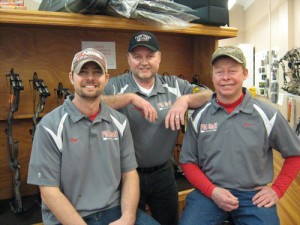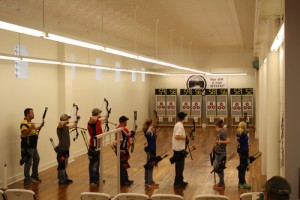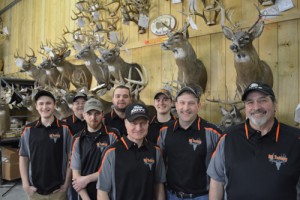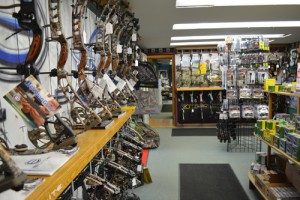Plum Creek Archery
Tom, Bruce and Ben Goldsmith
204 First Avenue E,
Dyersville, IA 52040
(563) 875-7525
www.plumcreekarchery.com
 “Our aim is your success.” That’s the motto of Dyersville, Iowa-based Plum Creek Archery. Opened in May 2010 by brothers Tom and Bruce Goldsmith and Bruce’s son Ben, Plum Creek has quickly become a popular and highly esteemed archery pro shop thanks to the team’s focus on improving their customers’ success.
“Our aim is your success.” That’s the motto of Dyersville, Iowa-based Plum Creek Archery. Opened in May 2010 by brothers Tom and Bruce Goldsmith and Bruce’s son Ben, Plum Creek has quickly become a popular and highly esteemed archery pro shop thanks to the team’s focus on improving their customers’ success.
Although Plum Creek Archery continues to grow – it recently moved into a new, larger facility – the hard-working trio have also kept their day jobs: Tom is a mechanical engineer, Bruce is a farmer and Ben is an HVAC technician.
“What makes it easy is that it’s fun,” Tom said. “We all enjoy helping customers succeed in what they do. We want them to feel that we’re working for them, rooting for them to do the best that they can. So that makes it fun, which makes it easier, which makes it seem like not so much work.”
The team is also focused on growing archers by appealing to recreational shooters and introducing kids to archery. After our interview was over, Tom sent emails about his JOAD archers as he remembered things he wanted to add. “I want to brag up some of our students,” he wrote. His pride in the success of his students was clear, as was his passion for sharing archery with others.
In addition to Tom, Bruce and Ben, Plum Creek employs two part-time employees, Duane Fox and his daughter Taylor. The team gets additional support from nine enthusiastic staff shooters, who get the word out about the shop at local events.
AB:What are the specific keys to your success?
Tom:Probably the old cliché: customer service. Every time we engage a customer we want them to feel like we’re on their team. Not a salesperson trying to get a sale, but a team member trying to help them solve a problem or improve something.
During our busy season, even though the techs may be busy working with a customer, any customer entering the store gets acknowledged, and we determine what they need. We give them an indication of the possible wait time and invite them to look around or relax in the lounge. Most of them have no problem waiting. They know they’ll be getting the same professional assistance as the customer in front of them.
We try to be very transparent. When customers come in for service, we have a checklist that we go through so they know exactly what work we’ve done. They can watch us do the work from our service counter and ask questions. We feel that the more we educate them in what we’re doing, the more confidence they have in what we’ve done for them.
We utilize the tools available to us. Not only the latest shop tools, but also business tools, starting with the ATA Archery Academy and other programs ATA offers, like Explore Bowhunting. We take advantage of the ATA seminars every year. Last year we incorporated a point-of-sale system to manage ordering, inventory, sales, customer notes, etc. That has saved us time, but has also made us more profitable by being much more accurate and giving us the ability to monitor business by evaluating reports.
The other thing is we’re all certified coaches through USA Archery. We’re able to help them with their form and shooting style so their overall success is better. And being able to provide individual lessons and classes because of that certification makes better use of our ranges.
Another factor is the JOAD program. It really starts providing a sustainable customer base. If you get them young, you keep them as customers.
AB:What are some hard lessons that have made you a better dealer?
 Tom:I would say probably learning how to buy appropriately. You don’t want to overbuy. You hate to have previous-year inventory because everybody wants the latest and greatest. So we’re buying more conservatively and buying several times a year. That way you’re turning inventory more; it’s better cash flow.
Tom:I would say probably learning how to buy appropriately. You don’t want to overbuy. You hate to have previous-year inventory because everybody wants the latest and greatest. So we’re buying more conservatively and buying several times a year. That way you’re turning inventory more; it’s better cash flow.
We work with the distributors. They do a really good job for us. We’re also an ARRO member, so we’re making better profits because of the deep discounts.
AB:How do you work at growing your customer base?
Tom:Word of mouth is still king in this industry. We never get tired of hearing a new customer say, “You came highly recommended.” That always makes us feel good.
We have a website. We have a Facebook page, and that’s been a good way to get information out. We keep an email list of customers who want to be on our customer list so when we have something going on like leagues coming up or some special event or sale, we’ll send out an email blast. It’s very cost effective.
We have the TechnoHunt system, and we use that to get new people into the shop. Let’s say somebody’s having a benefit event. We give out a free TechnoHunt for the raffle. We give it for six people, so it gets people into the store. And it really doesn’t cost us much.
We also do birthday parties and corporate events, which gets different people into our store. They may not even have thought about archery until they happened to come to a birthday party.
And then doing things in the community. We’ll do free presentations for the schools. It keeps your name moving throughout the community.
AB:What products are you excited about selling and why?
Tom:Anything our customers are excited about. Usually it’s after we get back from the ATA Show and have seen all the new products – or new features on old products – from the manufacturers that we carry. But we also look for something that we don’t have that’s kind of new and fun. Like this year happened to be MegaBOOM. You just take a plastic water bottle or a pop bottle and use this unit to pump it full of compressed air. And then when you shoot it with an arrow it makes a sonic rip and very loud noise. We ended up starting to sell those, and they’re going like hotcakes right now. We try to find something like that every year.
AB:How has the growing interest in recreational archery impacted your shop?
Tom:Probably one of the biggest changes we made to get more of the recreational business is we purchased a larger building. We created more shooting lanes. For people who just want to try it, we rent them a bow and give them a short lesson. Sometimes they end up falling in love with it and wanting to purchase their own. We’ve grown our bow sales that way.
When we purchased the building and remodeled, we changed how the shop looks as well. When you first walk into the store, we tried to make it very comfortable and inviting. We still have trophy mounts, but they’re in the back toward the shop where the bowhunters can still enjoy them. We also built a new bathroom to make it very modern, very clean, very approachable.
We added spectator seating to our ranges. This is more inviting for parents of JOAD students, and it’s beneficial during tournaments. We decided to put in monitors and use archery tournament software for running tournaments – makes them run smoothly and on time. We even created a format – we call it the PCA Fallout – where there are two qualification rounds at different targets and yardage, then the top 16 get seeded for head-to head competition. We use live scoring for the final eight to get the spectators more involved. We handicap leagues so that the novice recreational archer still gets involved with chasing the prize.
We offer a two-day camp (PCA Camp) in the summer for youth. We give them instruction on archery in general as well as shooting form. We also teach them about different archery tournaments and games they can enjoy as well as discussions on bowhunting.
One of the most rewarding things for me is coaching kids who like to shoot competitive tournaments. We have two National Champions (both girls age 12 and 14) and several state champions. At the recent State NFAA tournament, we had eight kids attend and seven of them medaled. Two were new State Champions, and one set a new State record. We had 50 youth in our JOAD program this year, with about 30 being new to the sport.
S&S Taxidermy
Brian Stedman
455 S. Cascade Drive (Route 219),
Springville, NY 14141
(716) 592-2404
www.sstaxidermy.com
 It’s hard to imagine a less auspicious beginning for an archery shop than that of S&S Taxidermy.
It’s hard to imagine a less auspicious beginning for an archery shop than that of S&S Taxidermy.
Not that S&S Taxidermy as a whole got off to a bad start. Jerry Stedman started the company as a taxidermy shop in 1968. Jerry ran S&S out of his home, and his belief that customers should be treated like family helped win the company a strong, loyal customer base.
Soon, Jerry’s son Brian joined the company. The wheels started turning when Brian, an avid bowhunter, noticed a small magazine ad for a bow company. “I thought maybe I could get my own stuff at cost,” Brian explained. “And I could get my friends stuff, too.” Soon, friends of friends were asking about purchasing archery equipment from Brian. When Brian asked his father about selling archery equipment at S&S, his father agreed to let him start with five bows.
The bows arrived while Jerry was at work. Brian and an S&S employee opened the box and pulled out the first bow. Then the employee pulled the bow back and dry-fired it.
And from that somewhat disastrous start grew a major archery retail success story. Driven by that same philosophy of treating others as you want to be treated, the archery side of the business boomed. Eventually, S&S Taxidermy moved from its 1,500-square-foot facility to a 14,000-square-foot building conveniently located between Pennsylvania and Buffalo, New York. The shop now draws customers from 70+ miles away. Although Jerry has technically retired from the business, he remains a fixture at the shop. Brian has been joined in the business by son Bryce and daughter Riley.
Even with all that he’s accomplished, what Brian values most are the relationships he’s developed in the industry, particularly with the manufacturer’s reps that keep him informed, support the show he puts on every March and have become friends. “The friendships mean more than collecting a paycheck,” he said – although he did add that his wife would probably disagree.
AB:What are the specific keys to your success?
Brian:Honesty is probably number one. Treat everybody like you want to be treated. I’ve had bad experiences like everybody else has in certain stores, and I try to treat people how I want to be treated.
Have fun. Enjoy what you do. When it becomes a job, you know there’s something wrong. I look forward to going to work. Not many people can say that.
AB:What are some hard lessons that have made you a better dealer?
Brian:I’ve made all the mistakes that everybody else has. I once ordered 500 sights at the ATA Show that didn’t sell. You have to really pay attention to the trends. There are certain things that sell every year. You always have to have X amount of releases, X amount of broadheads. Certain brands are always going to sell. But you can’t get caught up in trendy niche products. You have to be really careful with your inventory.
Everything I stock in my store, somebody’s come in and asked me for. Reps will come to me and say, “This is the newest, latest, greatest product.” I say, “Okay, where are you advertising?” They’ll tell me where they’re advertising, and I’ll say, “When customers come to me and want this, I’ll start stocking it.” Sometimes they do. And sometimes I never hear again about this new product.
You have to be smart about it and not get in so deep that you can’t get out. It’s like buying used bows. I’ve seen archery shops have $50,000 in inventory in used bows. They’ll never sell them. You might as well use them as tomato stakes.
AB:How do you work at growing your customer base?
Brian:There’s no better advertising than word of mouth. And we’ve been doing it for so long, that just about everybody knows about us.
 We have hunter safety and archery safety training classes here. I think everybody who’s ever taken a course like that remembers where it was even if it was 30 years ago, and they usually look at it in a good light because that’s where they got their hunting license.
We have hunter safety and archery safety training classes here. I think everybody who’s ever taken a course like that remembers where it was even if it was 30 years ago, and they usually look at it in a good light because that’s where they got their hunting license.
Schools, clubs, shoots, stuff like that – we try to always help kids out. We go up to this outdoor show outside Buffalo the first weekend of March and we rent space. We take some bows, some crossbows and some mounts. Of course, we try to sell a few bows, but it’s really a PR thing. It costs me a lot money to do this show, but we promote the show here at the store.
We hold our show the last Saturday in March. I give a certain amount off of bows and accessories. It’s our best price of the year, we always say. In eight hours, I probably run 700 to 800 people through the store. It’s amazing. We set up all the new bows and crossbows, and you can come down here and shoot every new bow there is from eight different manufacturers and decide what you want to buy.
We have the New York State Big Buck Club here, and they score racks. People come and watch the racks get scored. We try to include local businesses and as many manufacturer’s reps as we can get. We have a great time.
I also try to be a student of people. Like when there’s a complaint. It’s not every day, but you get people who aren’t happy. I want to take care of them because I want to figure out what I can do to make it better. It’s a challenge to have that guy walk in really upset and walk out of here happy saying he’ll be back. Ninety percent of the time that happens. You’re never going to make everybody happy, and I know that. It may be the fault of a product or the misuse of a product. Crossbows have been a real eye-opener for us. I think people have invented ways to break them.
You have to teach people how to use the equipment. Every bow or crossbow we sell, we take them out on the range and we shoot it with them. Then we give customers a range card – five hours of archery range use for free. That gets them back in your door. First of all, maybe they’ll buy something. Secondly, if they have any issues, we’ll take care of it. I tell them, “Your range card is good for your family. Bring a friend, bring a buddy.” They’ll come back and maybe their buddy buys a bow. You can’t put a price on what it costs to get people in your door.
AB:Your shop is very close to a number of larger chain stores. How do you stay competitive?
Brian:We’re a stone’s throw from Walmart. Do we lose business to them? Sure. You just have to be smart. Don’t sell what they sell, but service everything they sell.
It’s a small world. They just built a Cabela’s up north of us, maybe 20 miles. There’s a Gander Mountain, there’s a Dick’s Sporting Goods, there’s the Walmart. I know all the guys that work there. They’ll call me if they need something. I’ll call them if I need something. The biggest thing to remember in business is never badmouth anybody. There are things that Walmart and Cabela’s do better than me. There are things that I do better than them. There are things I sell that they don’t sell.
Cabela’s has only been open maybe eight months. We saw a big hit at Christmas. It was new. It was different. A lot of people went up and bought gift certificates, crossbows, things like that. And that’s fine. I know they bought a ton of them there because they buy them there and bring them here to get put together. You just charge for your time. You just say, “Hey, you bought that at Cabela’s? That’s a great crossbow. Let me take you out on the range and show you how to shoot it. Let me help you sight it in. If you ever need anything, give me a call.” And they come back. They always do.
AB:How has the growing interest in recreational archery impacted your shop?
Brian:That’s taken off a little bit. We carried a few more recurves because of The Hunger Games. It hasn’t had a huge impact on us.
We’re seeing a lot more women hunters, though, which is neat. And the industry is building bows for ladies. A lot more youth bows. You get the kids hooked on it and really having fun. They’re not taking grandpa’s bow and trying to tie the string in a knot to get the draw length short enough to shoot it. Not trying to muscle back 60 pounds when they should be pulling 40. There are so many choices out there that it makes it a lot easier to sell them. And more fun. Because when it fits them and it’s comfortable to shoot, they want to shoot more.






